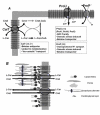Production of L-carnitine by secondary metabolism of bacteria
- PMID: 17910757
- PMCID: PMC2131755
- DOI: 10.1186/1475-2859-6-31
Production of L-carnitine by secondary metabolism of bacteria
Abstract
The increasing commercial demand for L-carnitine has led to a multiplication of efforts to improve its production with bacteria. The use of different cell environments, such as growing, resting, permeabilized, dried, osmotically stressed, freely suspended and immobilized cells, to maintain enzymes sufficiently active for L-carnitine production is discussed in the text. The different cell states of enterobacteria, such as Escherichia coli and Proteus sp., which can be used to produce L-carnitine from crotonobetaine or D-carnitine as substrate, are analyzed. Moreover, the combined application of both bioprocess and metabolic engineering has allowed a deeper understanding of the main factors controlling the production process, such as energy depletion and the alteration of the acetyl-CoA/CoA ratio which are coupled to the end of the biotransformation. Furthermore, the profiles of key central metabolic activities such as the TCA cycle, the glyoxylate shunt and the acetate metabolism are seen to be closely interrelated and affect the biotransformation efficiency. Although genetically modified strains have been obtained, new strain improvement strategies are still needed, especially in Escherichia coli as a model organism for molecular biology studies. This review aims to summarize and update the state of the art in L-carnitine production using E. coli and Proteus sp, emphasizing the importance of proper reactor design and operation strategies, together with metabolic engineering aspects and the need for feed-back between wet and in silico work to optimize this biotransformation.
Figures







Similar articles
-
Metabolic engineering for high yielding L(-)-carnitine production in Escherichia coli.Microb Cell Fact. 2013 May 29;12:56. doi: 10.1186/1475-2859-12-56. Microb Cell Fact. 2013. PMID: 23718679 Free PMC article.
-
Salt stress effects on the central and carnitine metabolisms of Escherichia coli.Biotechnol Bioeng. 2007 Mar 1;96(4):722-37. doi: 10.1002/bit.21128. Biotechnol Bioeng. 2007. PMID: 16894634
-
Link between primary and secondary metabolism in the biotransformation of trimethylammonium compounds by escherichia coli.Biotechnol Bioeng. 2003 Dec 20;84(6):686-99. doi: 10.1002/bit.10822. Biotechnol Bioeng. 2003. PMID: 14595781
-
Ectoines in cell stress protection: uses and biotechnological production.Biotechnol Adv. 2010 Nov-Dec;28(6):782-801. doi: 10.1016/j.biotechadv.2010.06.005. Epub 2010 Jul 1. Biotechnol Adv. 2010. PMID: 20600783 Review.
-
Regulation by carnitine of myocardial fatty acid and carbohydrate metabolism under normal and pathological conditions.Basic Res Cardiol. 2000 Apr;95(2):75-83. doi: 10.1007/s003950050167. Basic Res Cardiol. 2000. PMID: 10826498 Review.
Cited by
-
Metabolic engineering for high yielding L(-)-carnitine production in Escherichia coli.Microb Cell Fact. 2013 May 29;12:56. doi: 10.1186/1475-2859-12-56. Microb Cell Fact. 2013. PMID: 23718679 Free PMC article.
-
Systems biology and biological systems diversity for the engineering of microbial cell factories.Microb Cell Fact. 2007 Nov 20;6:35. doi: 10.1186/1475-2859-6-35. Microb Cell Fact. 2007. PMID: 18028536 Free PMC article. No abstract available.
-
L-Carnitine Production Through Biosensor-Guided Construction of the Neurospora crassa Biosynthesis Pathway in Escherichia coli.Front Bioeng Biotechnol. 2021 Apr 16;9:671321. doi: 10.3389/fbioe.2021.671321. eCollection 2021. Front Bioeng Biotechnol. 2021. PMID: 33937222 Free PMC article.
-
The Impact of Carnitine on Dietary Fiber and Gut Bacteria Metabolism and Their Mutual Interaction in Monogastrics.Int J Mol Sci. 2018 Mar 28;19(4):1008. doi: 10.3390/ijms19041008. Int J Mol Sci. 2018. PMID: 29597260 Free PMC article. Review.
-
Benefits and Drawbacks of Harboring Plasmid pP32BP2, Identified in Arctic Psychrophilic Bacterium Psychrobacter sp. DAB_AL32B.Int J Mol Sci. 2019 Apr 24;20(8):2015. doi: 10.3390/ijms20082015. Int J Mol Sci. 2019. PMID: 31022896 Free PMC article.
References
-
- Löster H. Carnitine and cardiovascular diseases. Bochum: Ponte Press Verlags GmbH; 2003.
-
- Naidu GSN, Lee IY, Lee EG, Kang GH, Park YH. Microbial and enzymatic production of L-carnitine. Bioprocess Eng. 2000;23:627–635. doi: 10.1007/s004490000212. - DOI
-
- Seim H, Eichler K, Kleber HP. L-carnitine and its precursor, γ-butyrobetaine. In: Kramer K, Hoppe PP, Packer L, editor. Nutraceuticals in Health and Disease Prevention. New York: Marcel Dekker, Inc; 2001. pp. 217–256.
LinkOut - more resources
Full Text Sources
Other Literature Sources

